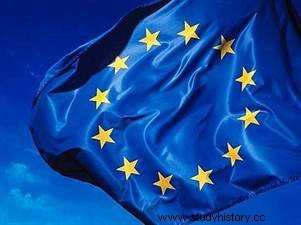 March 25, 1957 the representatives of the Federal Republic of Germany, France, Italy, Belgium, the Netherlands and Luxembourg sign the Treaty of Rome establishing the European Economic Community (EEC ). A key symbolic episode in European construction, this treaty is the result of efforts already made within the framework of the ECSC (European Coal and Steel Community, created in 1951).
March 25, 1957 the representatives of the Federal Republic of Germany, France, Italy, Belgium, the Netherlands and Luxembourg sign the Treaty of Rome establishing the European Economic Community (EEC ). A key symbolic episode in European construction, this treaty is the result of efforts already made within the framework of the ECSC (European Coal and Steel Community, created in 1951).
Birth of the EEC (1957)
The first steps towards European integration were taken in 1951 with the creation of the European Coal and Steel Community (ECSC), a European Community authority controlling the European coal and steel industries. After the failure of the European Defense Community project, European construction took a new step under the impetus of Jean Monnet and Robert Schumann with the creation of a customs union, the EEC . It will have its own institutions, including the Commission (supranational executive), the Council of Ministers (intergovernmental council), a Parliamentary Assembly (ancestor of the current European Parliament) and a Court of Justice.
 The goal of the new organization is then of great ambition since it is neither more nor less the economic integration of its member states into a common market. Signed in Rome in 1957, The Treaty establishing the European Community has as its objectives the removal of all obstacles to trade between the Member States (by means of the abolition of customs duties and the establishment of a common external tariff), the free movement of factors of production ( capital and labour), free competition, as well as freedom of enterprise in all member countries.
The goal of the new organization is then of great ambition since it is neither more nor less the economic integration of its member states into a common market. Signed in Rome in 1957, The Treaty establishing the European Community has as its objectives the removal of all obstacles to trade between the Member States (by means of the abolition of customs duties and the establishment of a common external tariff), the free movement of factors of production ( capital and labour), free competition, as well as freedom of enterprise in all member countries.
A common agricultural policy is put in place within the framework of the Treaty (PAC), in 1962, which fixes guaranteed common prices for agricultural and livestock production in order to protect Community agriculture from low-cost imports and to guarantee farmers' incomes, industrial policies, transportation, etc. See Economic and Monetary Union (EMU) for more recent EU policies.
The new European institutions
The Treaty enters into force on January 14, 1958. The institutions of the EEC are largely inspired by those of the European Coal and Steel Community (ECSC), certain bodies even being common. The Commission , the policy impetus body, guardian of the Treaties and Community interests, is the heir to the “high authority” of the ECSC. The Council of Ministers (meeting of ministers from each member country for a given sector, such as agriculture, for example), an intergovernmental rather than a supranational institution, holds decision-making power. The European Court of Justice (the judicial body) and the Assembly (a body later called the European Parliament, where the citizens of Europe are represented and which holds part of the legislative power) are institutions common to the EEC, the ECSC and Euratom. Another treaty aimed at merging the Commission and the Council of Ministers with those of the ECSC and Euratom was signed in 1965 and entered into force on January 1, 1967.
The election by universal suffrage of the European Parliament , provided for by the Treaty of Rome, was implemented by an act of the representatives of the governments of the Member States of 20 September 1976. The first election under this system took place in 1979.
From the EEC to the European Union
The Single European Act , signed on 28 February 1986 and entered into force on 1 st July 1987, is commonly presented as the first major revision of the treaties. These are in fact two separate acts, one revising Community provisions (at the institutional level, it involves adding a court of first instance to the European Court of Justice), the other establishing political cooperation in foreign policy.
We can see that this institutional architecture spares national sensitivities while opening the door to the principle of a supranational organization. This intergovernmental/supranational dialectic will subsequently constitute the heart of the debates concerning the subsequent evolution of the EEC, which will eventually lead to the birth of our current European Union (Maastricht Treaty, 1992). Now endowed with a single currency, the Euro, and a European central bank, it will not be able to have a constitution after the failure of the 2005 referendum. The Lisbon Treaty , signed in 2007, governs the current functioning of the European Union, which today has 27 members.
To go further
- History of the construction of Europe since 1945, by Sylvain Kahn. PUF, 2018.
- History of the European Union:Foundations, Enlargements, Future, by Gérard Bossuat. Belin, 2009.
